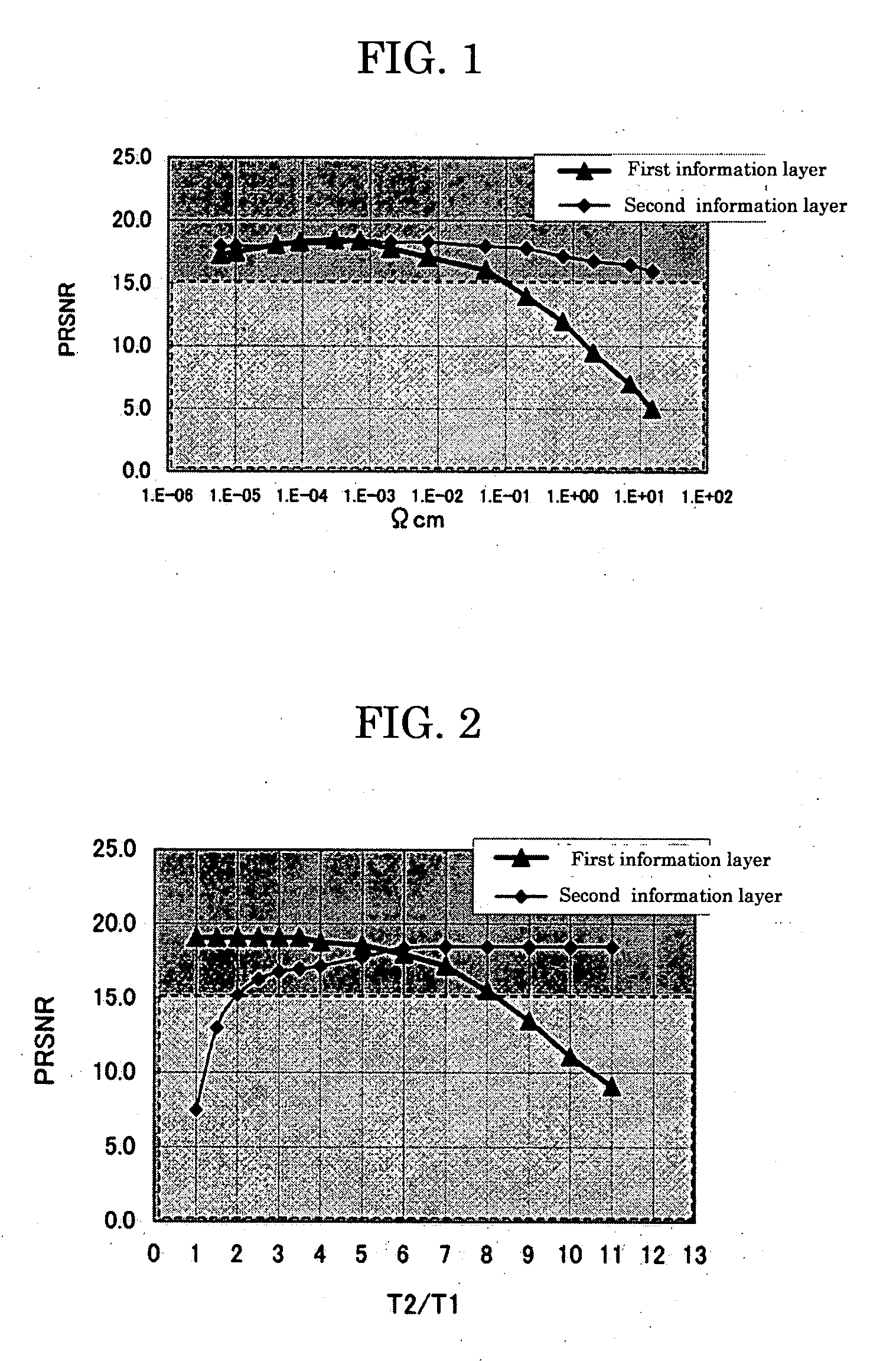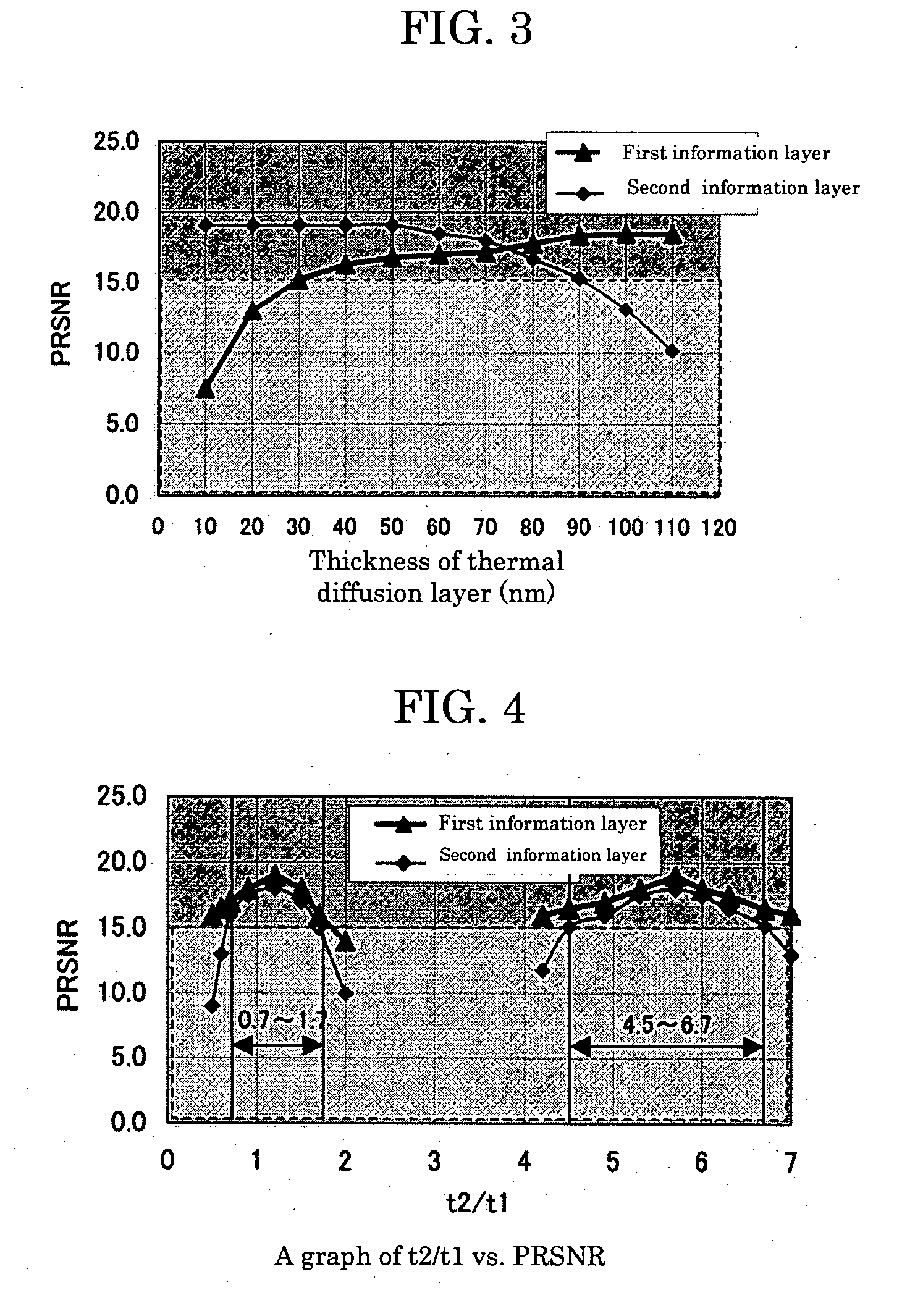Dual-layer recordable optical recording medium
a recording medium and recordable technology, applied in mechanical recording, record information storage, instruments, etc., can solve the problems of low carrier-to-noise ratio, increase manufacturing costs, and reduce the commercial value of the disc, so as to improve the recording characteristics of the first information layer, high reflectivity, and high sensitivity
- Summary
- Abstract
- Description
- Claims
- Application Information
AI Technical Summary
Benefits of technology
Problems solved by technology
Method used
Image
Examples
example 1
[0100] First and second substrates made of polycarbonate resin were first prepared, each of which is 120 mm in diameter and 0.58 mm in thickness and has a groove (depth=21 nm; track pitch=0.43 μm) on its surface
[0101] In single-wafer sputtering equipment (Balzers), a representative element-containing compound layer which is made of Al2O5 and 20 nm in thickness, a Re layer which is made of Bi2O3 and 20 nm in thickness, a dielectric layer which is made of ZnS—SiO2 (80:20(mol %)) and 20 nm in thickness, a reflective layer which is made of Ag and 156 nm in thickness, and a thermal diffusion layer which is made of IZO and 50 nm in thickness, were sequentially deposited on the first substrate to form a first information layer.
[0102] In a similar way, a reflective layer which is made of Ag and 100 nm in thickness, a dielectric layer which is made of ZnS—SiO2 (80:20(mol %)) and 20 nm in thickness, and a Re layer which is made of Bi2O3 and 20 nm in thickness, were sequentially deposited on...
example 2
[0108] Dual-layer recordable optical recording media were manufactured in a manner similar to that described in Example 1 except that various T2 / T1 ratios were set by changing T1 (the thickness of the Ag reflective layer of the first information layer) and T2 (the thickness of the IZO thermal diffusion layer), and PRNSR values were measured. More specifically, various T2 / T1 ratios were obtained by setting the Ag reflective layer thickness (T1) to 10 nm, 15 nm and 20 nm and by setting various thicknesses (T2) for each thickness.
[0109] As can be seen from the measurement results shown in FIG. 2, the line corresponding to PRSNR of the second information layer showed a rapid decline at T2 / T12 / T1>8.
example 3
[0110] Dual-layer recordable optical recording media were manufactured in a manner similar to that described in Example 1 except that thermal diffusion layers with various thicknesses were used. PRSNR values were then measured.
[0111] As can be seen from the measurement results shown in FIG. 3, the line corresponding to PRSNR of the first information layer showed a rapid decline at the thermal diffusion layer thickness90 nm.
PUM
| Property | Measurement | Unit |
|---|---|---|
| thickness | aaaaa | aaaaa |
| thickness | aaaaa | aaaaa |
| thickness | aaaaa | aaaaa |
Abstract
Description
Claims
Application Information
 Login to View More
Login to View More - R&D
- Intellectual Property
- Life Sciences
- Materials
- Tech Scout
- Unparalleled Data Quality
- Higher Quality Content
- 60% Fewer Hallucinations
Browse by: Latest US Patents, China's latest patents, Technical Efficacy Thesaurus, Application Domain, Technology Topic, Popular Technical Reports.
© 2025 PatSnap. All rights reserved.Legal|Privacy policy|Modern Slavery Act Transparency Statement|Sitemap|About US| Contact US: help@patsnap.com



